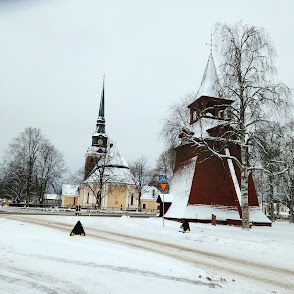Having driven all the way to Mora for the Lucia program, we chose to stay an extra day and see some sights. We were very glad we'd made this choice, because the 4-hour drive shown by all of the maps took more like 6, due to snow-packed, icy roads. We far prefer to take it a bit slowly and GET there, rather than go the speed limit and NOT get there at all! Traffic was such that we could easily go at a comfortable pace without blocking the way for more than a couple of people, and we used the pullouts whenever we could see them coming up in time.
Our hotel room was small but comfortable....and a little too close to the "main drag" on a Saturday night. Cars with VERY loud music were driving past until about 1 AM. Not something you expect in small-town Sweden....although Mora has grown into a much larger place than either of us realized, with over 10,000 residents.
After a lovely Swedish breakfast of ham and cheese on flatbread, filmjölk, muesli, etc., we set off to investigate Mora's two main claims to fame. A short walk across the park took us past the statue of Anders Zorn, one of Sweden's best-known artists. More on him later.
Then we came to the main street, running past the church and its separate bell-tower. This was common in an era when churches were built of wood. You wanted the bell far away so it could sound the alarm if the church caught fire!
Near the bell-tower was another statue, this one representing Mora's other claim to fame, the Vasaloppet ski race. Vasaloppet is an annual long distance cross-country ski race held in March, since the first one in 1922. It's now on the first Sunday of March. The 90 km course (the world's longest!) starts in the village of Berga, just south of Sälen in western Dalarna, Sweden, and ends in the town of Mora. People come from all over the world to compete, and the mass start must really be a sight to behold! You can get a sense of it here, along all the facts and stats you're likely to care about: https://www.vasaloppet.se/en/news/facts-statistics-news-and-trivia-ahead-of-vasaloppet-2022/#
All of the winners in the earliest years of the race were mailmen, who delivered the mail on skis and so were in great physical condition for this test of endurance. Currently, both men and women winners finish the 90 kilometers in under 4 hours. Some people, of course, take much, much longer.

The finish line and Mora-Nisse's house, where the Vasaloppet Museum is currently housed. Of course, it was closed! Mora-Nisse won the race more times than anyone else....NINE times!
The main office building for the race organizers (there are many other events throughout the year--a cycle race, foot races, and a "ski the course on your own" day in February, when anyone can give it a shot). That's Lars standing in front of the building. Plus, the map of the course.
Then we walked back up the street, past the church and on to Zorngården, where the artist Anders Zorn lived for much of his life. We just missed the 12:00 tour, so decided to eat lunch in the little cafe while we waited.
The house began as a two-room, two-story farmhouse, and was expanded bit by bit to reach today's expansive size. Furnishings are all actual pieces that were in the house when the Zorns lived there from 1896 until Emma's death in 1942, when the entire property was willed to the state. It was opened to the public that same year.
Anders and Emma were very interested in preserving the folk-culture of the area. Next to the house stands this typical storehouse, which is set up off the ground in order to deter critters from getting in. Farther away is the Zorn Gammalgård, where old buildings, costumes, textiles and handcrafts have been collected. He also started the annual Riksspelman (Fiddler of the Realm) competitions, to preserve the local folkmusic, and he and his wife started a home and school for orphans, as well as an organization to promote local handcrafts, the Mora Hemslöjd.
To the far left in the kitchen you can see part of the first hot-water heater in Sweden! Zorn saw one at the Chicago World's Fair, bought one, had it shipped to Sweden, then found that nobody knew how to install it. He sent a local craftsman to Chicago to learn how, and after installing Zorn's heater, the young man founded a plumbing business that still operates today! Zorn also had the first private telephone in Sweden. The number to call was....4.
After all of that, we had to go to the art museum and see some of Zorn's works! He is often referred to as "the Swedish Impressionist". I didn't take a lot of pics because the lighting was an issue. Feel free to look him up on line for more.
"In Mourning"
This is the painting that really started Zorn's career at age 20.
It has an amazing amount of very fine detail for a watercolor.
And a personal favorite--"Dance at Gopsmor"
And back to the cafe for fika!
They use a lot of saffron in baked goods this time of year, and Sheila has really developed a taste for it
"Downtown"
The scenery on the drive home through Älvdalen and Lillhärdal was gorgeous! Pristine, white snow on these lightly-travelled main roads. Driving conditions, not so great. All of the mapping programs assured us that this would be faster than taking the E-45 the whole way. We're not convinced. The "4-hour drive" took us more like 5 1/2. Didn't take any pics on the way down, but the E-45 looked much the same as this. Winter conditions, for sure.











































No comments:
Post a Comment